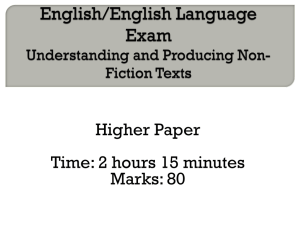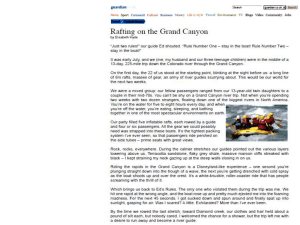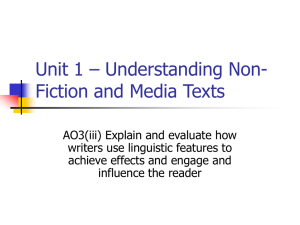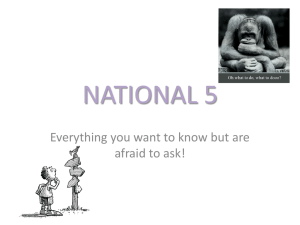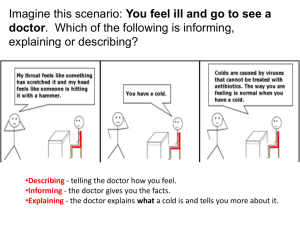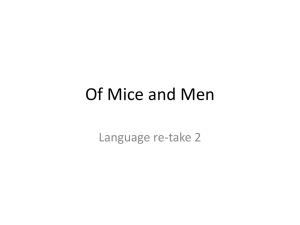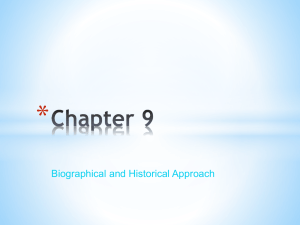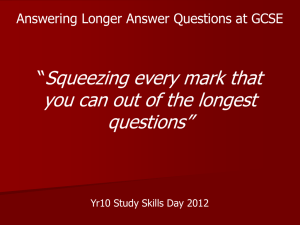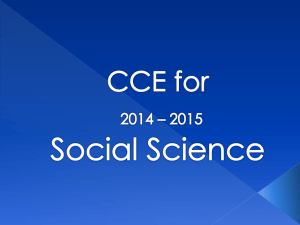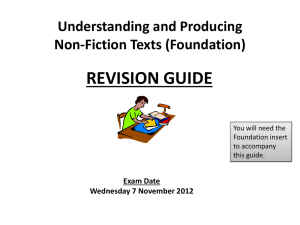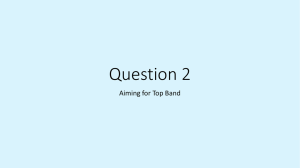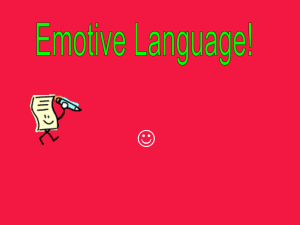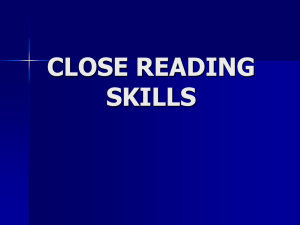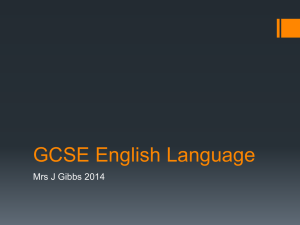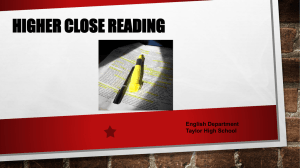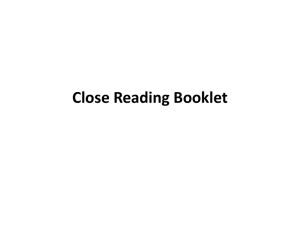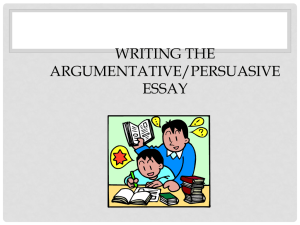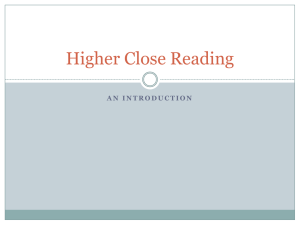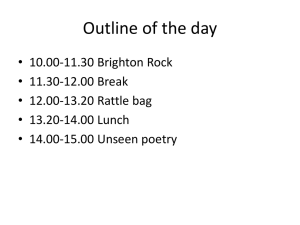Document
advertisement
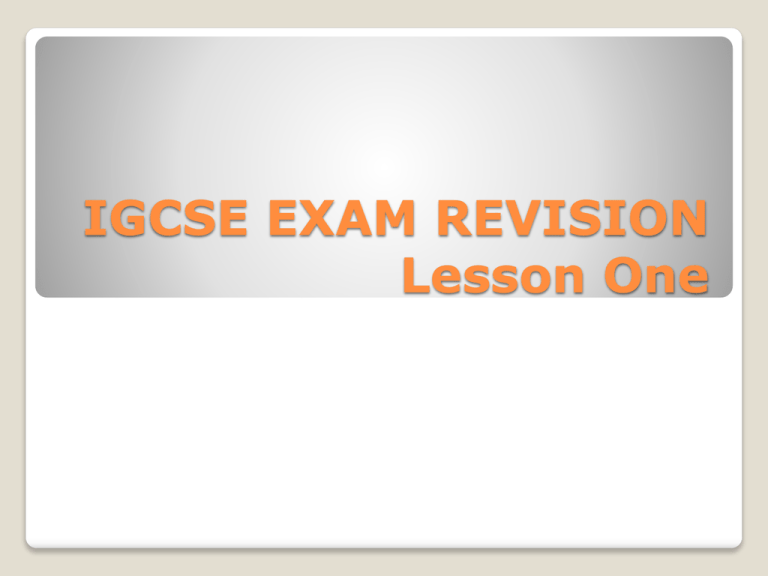
IGCSE EXAM REVISION Lesson One Cambridge IGCSE EXAM FORMAT There are two possible exams you can sit The Extension and the Core Paper. CORE PAPER (Foundation) 1 HOUR AND 45 MINUTES ANSWER TWO QUESTIONS ON ONE PASSAGE QUESTION ONE IS WORTH 30 MARKS QUESTION TWO IS WORTH 20 MARKS ELIGIBLE GRADES C-G 40% OF THE COURSES TOTAL MARKS EXTENSION PAPER (Higher) 2 HOURS 3 QUESTIONS ON TWO PASSAGES WHICH ARE LINKED BY A COMMON THEME QUESTION ONE IS WORTH 20 MARKS. QUESTION TWO IS WORTH 10 MARKS. QUESTION THREE IS WORTH 20 MARKS. ELIGIBLE GRADES ARE A-E 40% TOTAL MARKS EXTENDED PAPER EXAM TIMINGS Spend 15 minutes reading the two passages Question One 42 minutes Question Two 21 minutes Question Three 42 Minutes CORE PAPER Spend 10 minutes reading the passage Question One 55 minutes Question Two 40 minutes ASSESSMENT OBJECTIVES Both CORE and EXTENDED PAPERS are out of 50 marks. 40 of those marks are awarded on your reading skills 10 marks on your writing skills. Title Language Effects Learning Objectives: To be able to identify features of language and explain the effects they can have on a reader Today we are going to focus on one of the reading objectives. - R4 that is in both the CORE AND EXTENDED PAPER The four reading objectives are: R1 Understand and collate explicit meanings R2 Understand, explain and collate implicit meanings and attitudes R3 Select analyse and evaluate what is relevant to specific purposes R4 Understand how writers achieve effects. In the Extended Paper it is Question 2 that tests this reading objective To answer this type of question you need to be able to pick out and interesting words and phrases. You need to be aware of language features also known as linguistic devices. You also need to be confident in explaining the effect a certain word or phrase has on the reader. How is language used for effect? Language is always used for some kind of effect or other. Often, without commenting on specific linguistic devices, you can talk about the kind of language a writer uses, noticing what kind of words are used, or what kind of tone or style is created by language and structure. Look at these examples… The writer uses dramatic and violent language in order to describe the horror of the attack at the end of the extract. Phrases like “chill horror”, “sudden fear” and “thunderous crack” portray the fear and terror experienced by the Indians who are attacked. Powerful words such as “war”, “huge” and “ruining” emphasise and perhaps exaggerate the seriousness of the issue. The writer uses a chatty, informal tone, using contractions like “I’m” “don’t” and “can’t”. Language is highly descriptive, with adjectives such as “golden” and “spectacular” conveying the writer’s appreciation for his surroundings. Common linguistic devices • 1st, 2nd or 3rd person (narrative viewpoint) • Directly addressing the reader • Imperatives • Rhetorical questions • Register Formal/Informal language • Diction Simple/Complex vocabulary • Figurative Language & Imagery: Similes/Metaphor/ Personification etc. • • • • • • • • • • • • • • • Word play & puns Alliteration Rhyme & Rhythm Anecdote & Allusion Slogan & Catchphrase Statistics & Facts Exaggeration & Hyperbole Repetition Humour Lists Emotive language Punctuation type Expert advice Short sentences Superlatives Language Features 1. Match the technique to the definition Direct Address/Audience A. Invites trust, suggests knowledge. involvement B. Use of words like 2. Anecdote 3. Emotive Language 4. Using facts and figures demand/urge/want/frightening C. Ideas presented in a way that seems opposite to what is really meant D. Little stories to involve reader/create 5. Rhetorical Questions 6. Short sentences E. Using words such as ‘you’, ‘we’, ‘us’ or ‘I’ 7. Expert opinion F. Questions that can not be answered 8. Irony/Sarcasm G. To shock/surprise – make reader believe sympathy writer is knowledgeable H. Gets message across To prepare yourself for answering Question 2 COMPLETE THE PIXEL THERAPY AND TESTING HANDOUTS. Tips for answering -Extended Paper Question 2 Spend your time equally on both paragraphs/parts of the question Highlight a range of words and phrases that seem powerful to you from both paragraphs. Put quotation marks around your choices. Avoid general comments such as the ‘writer makes you feel that you are really there’ or ‘this is a descriptive phrase.’ To explain effects, think of what the reader sees and feels when reading the word or phrase. You need to use up to five examples from each paragraph. One or two examples are not enough to get 7-10 marks. YOU MUST NEVER USE THE FOLLOWING PHRASES!!! The language is good The language eye-catching The language is effective The language is interesting The language makes the reader think The language means… … UNLESS YOU EXPLAIN WHY Using PEEL Point – Identify a technique Evidence – Give a short quotation Explain – The effect of this technique on the reader Link – Refer back to the question (repeat some of the words) EXAM PRACTICE Extended Question 2 Bear Grylls Read the extract as a group. Re- read the descriptions of: A) The fall in paragraph 3, beginning ‘‘I flip on to my front’’ B) The accidents in paragraph 5, beginning ‘‘Instead, I am in agony, writhing and crying.’’ Select words and phrases from these descriptions, and explain how the writer has created effects by using this language Write between 1 and 1 ½ sides, allowing for the size of your handwriting You have 21 minutes to answer the question EXAM PRACTICE Extended Question 2- 2012 paper Read the extract about Julia’s visit to the rainforest as a group Re-read the descriptions of: A) The rainforest and its wildlife B) in paragraph 1, from ‘The family was trudging...’ Julia’s walk through the rainforest in search of her parents in paragraph 4, from ‘hours later...’ Select words and phrases from these descriptions, and explain how the writer has created effects by using this language Write between 1 and 1 ½ sides, allowing for the size of your handwriting You have 21 minutes to answer the question PLENARY Read through the Model answer for this question as a group. Highlight particular sentences you think are good. In your book write down the top three things the writer has done.

